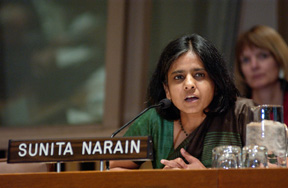
NEW DELHI: Reacting to the Intended Nationally Determined Contributions (INDC) announced by India, green bodies said that it was a much-awaited climate action plan and reflects the country’s development challenges, aspirations and the realities of climate change.
“India’s INDC is fair and is quite ambitious, specifically on renewable energy and forestry. It reflects its development challenges, aspirations of large numbers of poor people and the realities of climate change,” said Sunita Narain, director general, Center for Science and Environment.
“From all angles, India’s INDC is as good as China’s and better than the US’s considering that both these countries have higher emissions than India and are economically more capable of reducing their emissions and mitigating climate change,” deputy director general, CSE, Chandra Bhushan said.
In its INDC, India has pledged to improve emissions intensity of its GDP by 33-35 per cent by 2030 below 2005 levels. It has also pledged to increase the share of non-fossil fuels-based electricity to 40 per cent by 2030 while also agreeing to enhance its forest cover which will absorb 2.5 to 3 billion tonnes of carbon dioxide, the main gas responsible for global warming by 2030.
“India has accepted the huge impact that climate change is exerting and will exert on different sectors of its economy and has agreed to enhance investments to adapt in vulnerable sectors like agriculture, water resources, coastal regions, health and disaster management,” he said.
Greenpeace India has termed the climate targets as ‘steps in the right direction’.
According to Pujarini Sen, Climate and Energy Campaigner for Greenpeace India, clear articulation of a Renewable Energy target would also have been in keeping with expectations for climate justice, as these are the people most vulnerable to climate change.
“Given the growth in the renewable energy sector, we would have liked to see a specific target for solar and wind. 40 per cent of electricity from renewable energy by 2030 is definitely possible, especially so with financial and technical support,” said Sen.
Sanjay Vashist, Director, Climate Action Network South Asia (CANSA), said that India, through its INDC, demonstrates its willingness to play an important role on the international stage ahead of climate talks in December in Paris.
“India’s signal could no doubt be much stronger, going even further to help the international community avoid unmanageable climate impacts, should the rich and developed countries step up and provide adequate finance and technology support,” he said.
ActionAid India’s Executive Director, Sandeep Chachra said that despite huge developmental challenges, India has put forward a climate action plan that is far superior to ones proposed by the US and EU.
“India’s ambitious focus on energy efficiency and dramatic increase in renewable energy deserves credit but must lead to enhanced energy access for the poor.
This clearly puts the onus on developed countries to meet their obligations of providing public finance and technology transfer to developing and least developed countries,” he said.
India has also rightly put the focus back on the need to adapt to climate impacts, he said.
“Farming communities, who are already distressed, are suffering even more from erratic and extreme climatic conditions. Changes in India’s climate are leading to land and coastal degradation, soil erosion, loss of bio-diversity.
Indian government’s focus on adaptation therefore comes at a critical time for its population,” added Chachra.
CSE also called India’s INDC as “fair” and its renewable and forestry targets “ambitious” and said that the country’s emissions intensity targets are similar to that of China.
It said that China has pledged to reduce the emissions intensity of its GDP by 60-65 per cent during the same period and in 2030, both the countries will have almost same emissions intensity levels 0.12 million tonnes of CO2 per billion USD (in 2005 USD).
This means that both these countries will emit about 1,20,000 tonnes of CO2 for every 1 billion USD of GDP,” it said.
Talking about India’s pledge to install 40 per cent of its total electricity capacity from non-fossil fuel-based energy sources, CSE said it is more ambitious than even that of the US.
It said that in 2030, even under the most ambitious Clean Power Plan of President Obama, the US will only have about 30 per cent of its electricity capacity on non-fossils.
“CSE’s projections show that in 2030, India will have about 250-300 GW of solar and wind energy capacity. Under the Clean Power Plan, the US will reach 275 GW solar and wind capacity by 2030. China has pledged 300 GW solar and wind power by 2030,” it said.
Meanwhile, WWF India said that it is “laudable” that India has chosen to emphasize on aspects such as renewable energy, energy efficiency and afforestation.
It said that Indian INDC seeks to better adapt to climate change by enhancing investments in development programs in sectors vulnerable to climate change, particularly agriculture, water resources, Himalayan and coastal regions.
WWF India said that the country’s ambition of increasing the share of non-fossil fuel-based power capacity to 40 per cent by 2030 reverberates with WWF India’s vision of Renewable Energy.
“However, the critical aspect is to formulate a concrete action plan for implementation, which would help realize these targets. Additionally, planning and implementation of climate adaptation actions to enhance resilience and reduce vulnerability have been identified as a priority area.
“We see this as a positive declaration, with a spectrum of actions covering mitigation, finance, technology transfer, capacity building, R&D, and knowledge creation that would involve efforts by different stakeholders at the national as well as international level,” said Ravi Singh, CEO, WWF India.






